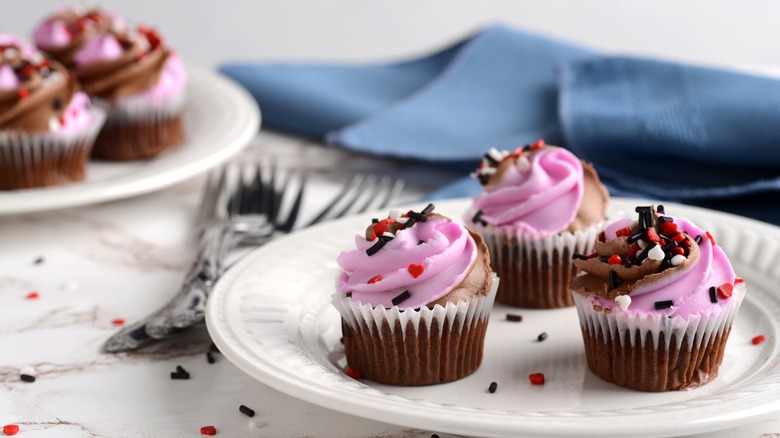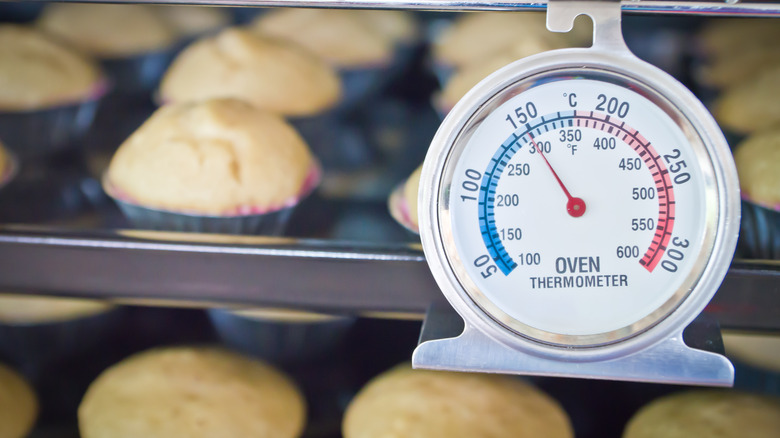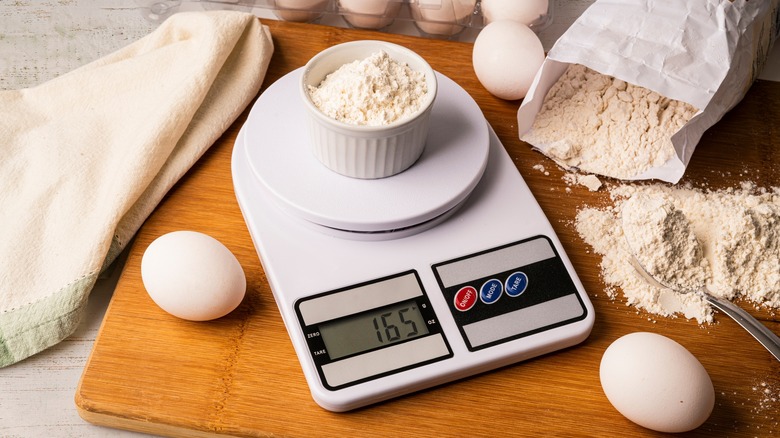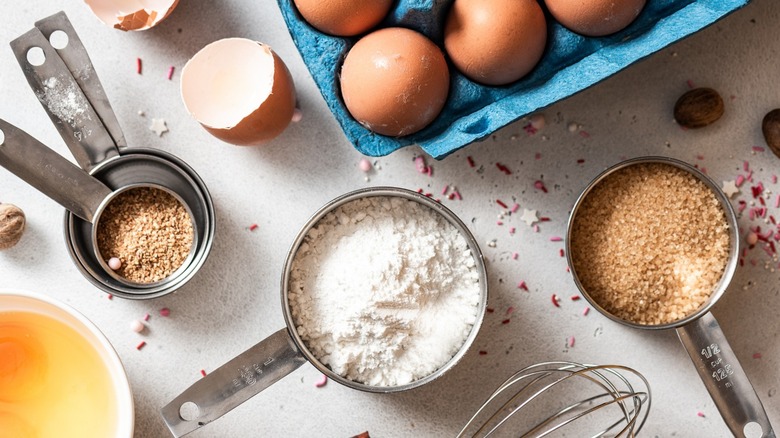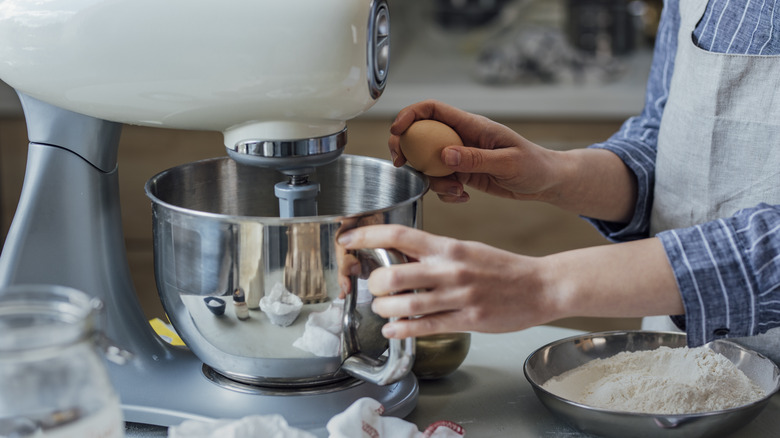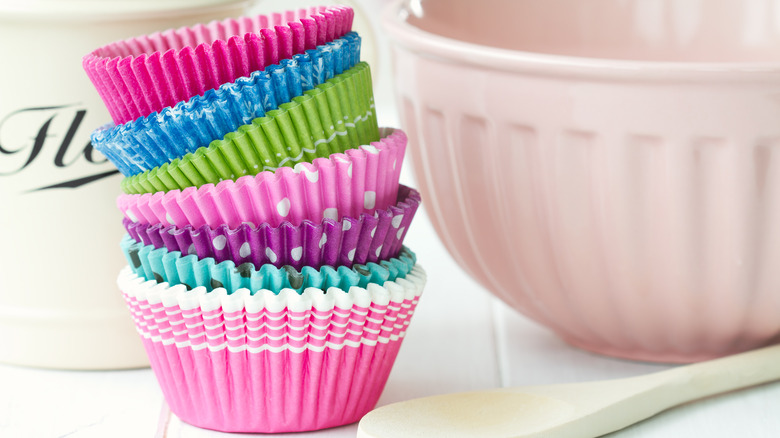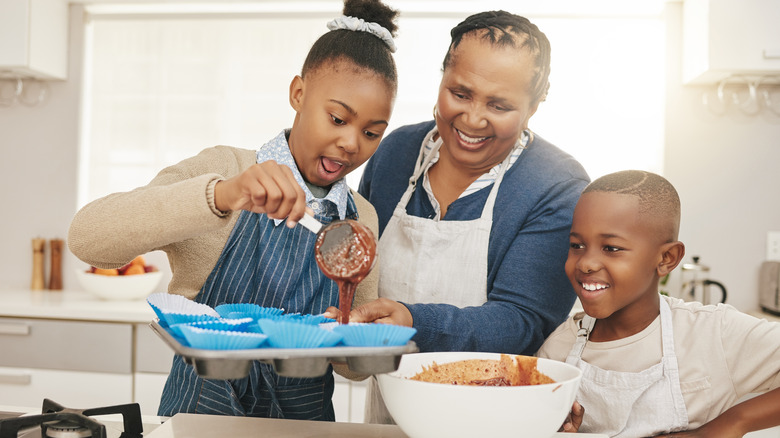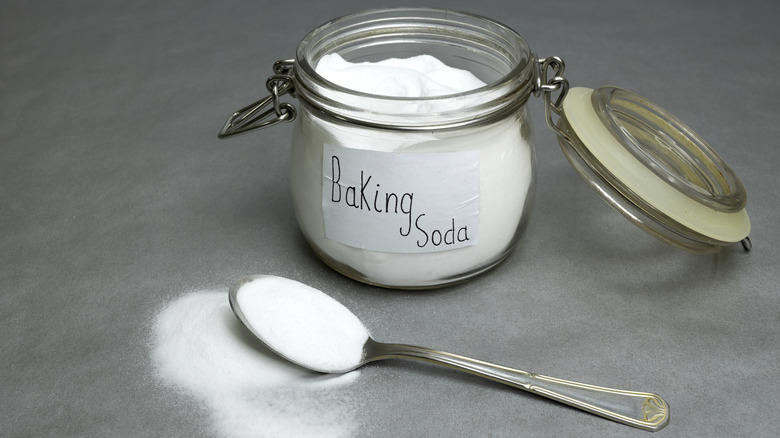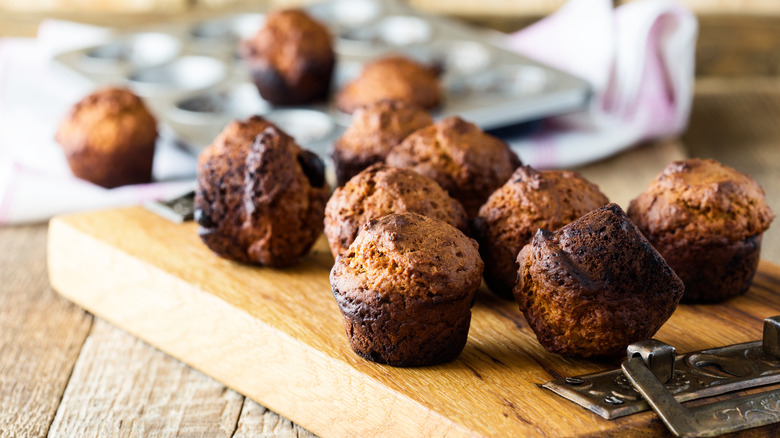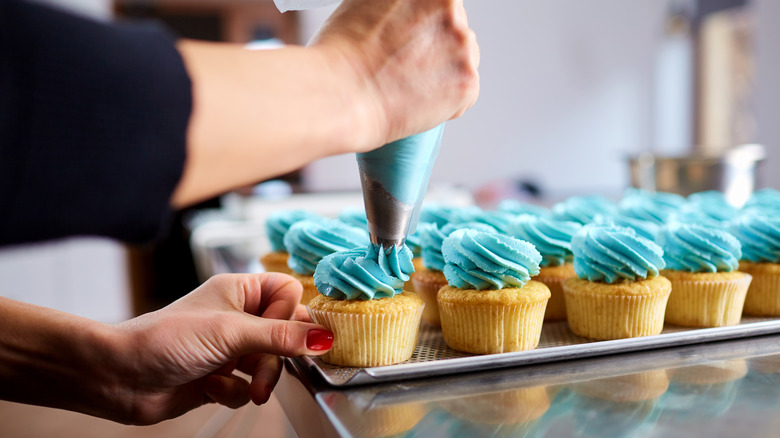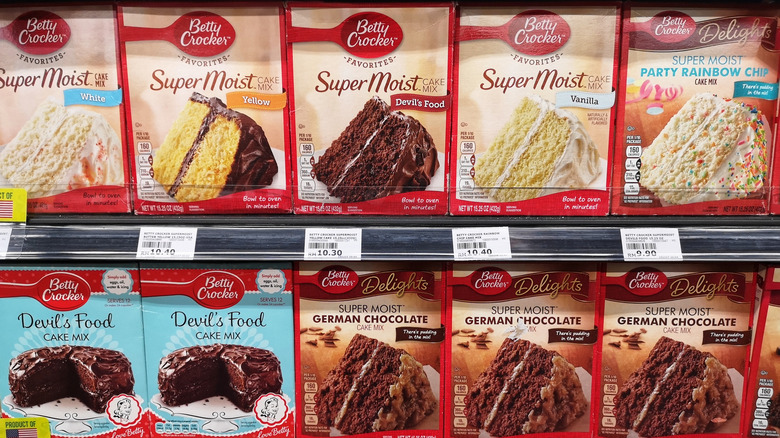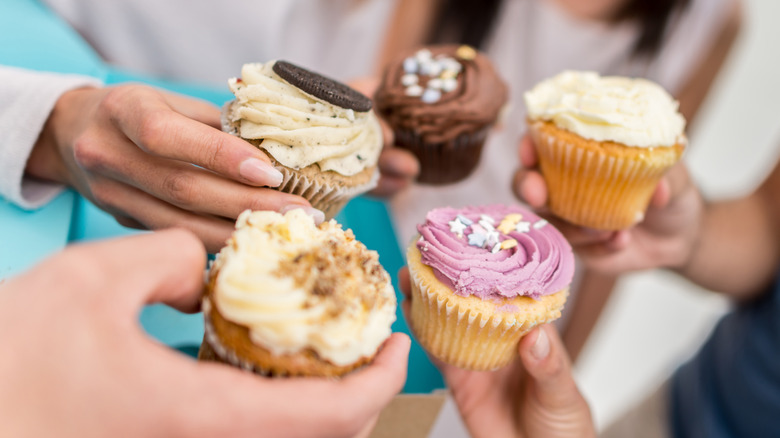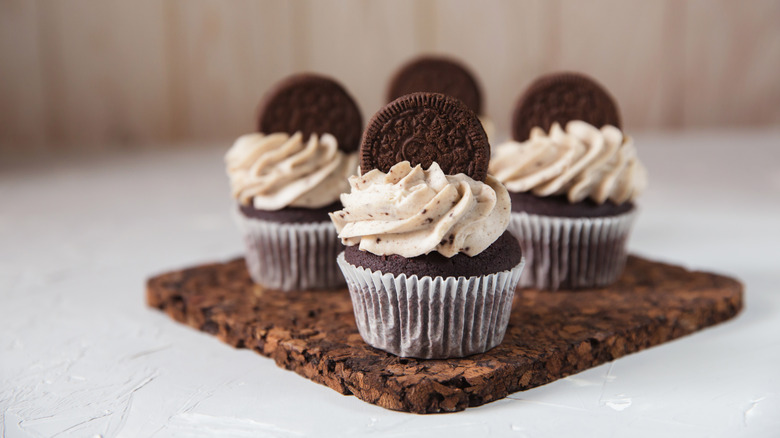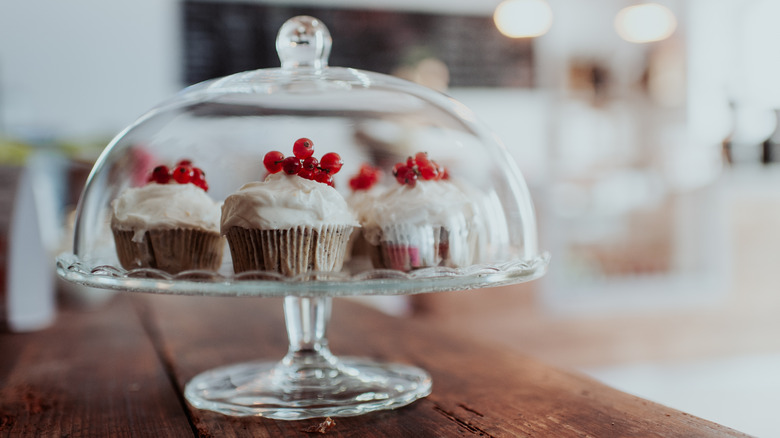17 Mistakes To Avoid When Baking Cupcakes
Cupcakes are a tasty and versatile treat. They can make an ideal dessert for many types of gatherings, including birthday parties, corporate events, and backyard barbecues. With so many flavor options and frosting choices, you can customize these treats to match your exact preferences or offer an assortment of options.
While baking cupcakes seems like a pretty basic task, there are actually several mistakes that people make when preparing them. Making one of these errors could leave you with cupcakes that are falling apart, stuck in the pan, have frosting that won't stay in place, look unappetizing, or simply don't taste good. Clearly, there is a lot that could go wrong. You'll need to take care to avoid these things the next time you're baking. Read on to learn more to help you ensure that each batch of cupcakes turns out moist, flavorful, and delicious.
1. Putting the cupcakes in a cold oven
Putting your cupcakes in a cold oven — or even one that hasn't reached the recommended temperature — is a mistake you don't want to make. It is essential to preheat the oven to the temperature recommended in the recipe — typically 350 degrees Fahrenheit. If the oven is still heating up when you put the cupcakes in, they're not going to bake evenly. This can prevent them from rising properly, cause their texture to be off, or interfere with them browning properly.
Another reason it's important to preheat the oven is to avoid letting the batter reach the danger zone. The danger zone is the temperature range between 40 and 140 degrees Fahrenheit in which bacteria can grow very rapidly. When cupcakes go into a cold oven, it will take them longer to warm up enough to exit the danger zone, making it more likely for bacteria to grow, which could result in someone getting food poisoning. Every oven is different, but as a general rule, plan to leave at least 20 minutes for the device to come to temperature.
2. Not verifying the temperature of your oven
Simply using the dial or digital controls to set the temperature of your oven isn't enough. Sadly, many ovens are not properly calibrated. This means that the actual temperature inside the oven could be different from what you think it is. Cupcake recipes are tested and intended for a specific temperature. If the temperature at which they're baked is off — even by a little — it will impact how they turn out. If you follow the recommended baking times, the cupcakes could end up burnt or undercooked.
To avoid these problems, you should always periodically check your oven temperature using an oven thermometer. This will help you know for sure that the temperature is where it should be. If you notice that the temperature is higher or lower than where you have it set, adjust it accordingly. You can also recalibrate your oven or hire a professional to help you.
3. Opening the oven while the cupcakes are baking
When you have cupcakes in the oven, you might want to open the door and check on their progress. However, it's important to avoid opening your oven while the cupcakes bake. Each time you open the door, heat escapes. This will cause the temperature inside the oven to drop, after which it will have to work to heat itself back up. The more times you open the oven, the more the temperature will fluctuate, which can cause your cupcakes to bake unevenly.
Beyond causing the temperature in the oven to drop, opening the door can also prevent your cupcakes from rising. When cold air rushes in, it can interfere with this process. The oven needs to remain closed for a minimum of three-fourths of the baking time. After that, checking on the cake's progress won't be as disastrous.
4. Not measuring the ingredients correctly
Whether you're making cupcakes from scratch or using a boxed cake mix, properly measuring the ingredients is important. While you may be able to increase or decrease the amount of seasoning you add to savory dishes like chicken or beef, the same doesn't apply when it comes to mixing flour, baking soda, baking powder, eggs, or other ingredients to make a cupcake batter. If the ingredients aren't precisely measured, then your cupcakes won't turn out as desired.
When baking cupcakes from scratch, be especially careful when measuring flour. If the flour is packed down too much, you'll end up adding more than is necessary. This will throw off the texture of the cupcakes. Using a kitchen scale is the best way to measure flour. If you don't have a scale, be sure to fluff up the flour inside your container, scoop some out using your measuring cup, then use a knife to scrape excess flour from the top of your cup.
5. Not letting the ingredients come to room temperature
Another mistake people often make when baking cupcakes is adding ingredients to the bowl without letting them warm up a bit. You should not take your eggs, butter, or any other ingredients that the recipe calls for out of the fridge and add them to your cupcake batter right away.
When you try to make the batter with cold butter or eggs, the ingredients won't mix properly. Sections of the batter are going to be warmer or colder than other areas, which can prevent your cupcakes from baking evenly. Cold eggs can also result in a lumpier batter. Remove the butter from the refrigerator about 45 minutes before you plan to bake cupcakes. You can place the eggs under warm running water for a few minutes to warm them up or let them sit on the counter for around 30 minutes.
6. Undermixing or overmixing the batter
You likely already know that undermixed cupcake batter will turn out lumpy. When baked, the cupcakes will still have some clumps of sugar or flour in them. When you bite into one of the cupcakes, you'll end up tasting these sections of unmixed ingredients.
While it is important to make sure that you mix the ingredients thoroughly, you don't want to end up overmixing it. Overmixing your batter can yield dense and gummy cupcakes — quite the opposite of the light and airy cake you're looking for. Instead, stir just until all of the ingredients are just combined, meaning that everything is incorporated and there are no lumps in the batter.
7. Forgetting to use cupcake liners
While you can make cupcakes without liners, you might not want to. Without liners, your cupcakes may stick to the inside of the pan, causing them to crumble and fall apart when you remove them. Liners also make it easier to serve cupcakes. When used, it's easier to handle the cupcakes, as they don't stick to your hands.
Instead of grabbing any pack of liners from the grocery store, consider spending a few extra dollars to purchase a high-quality product. Look for thicker liners that are grease-proof. This design makes it less likely that chunks of the cupcakes will get stuck on the side of the wrapper. You could also buy a set of silicone cupcake liners if you're looking for a reusable and more eco-friendly option.
8. Underfilling or overfilling each well
Most cupcake recipes simply state that you should pour the finished batter into the cupcake pan or liners. They don't specify how full each well of your cupcake pan should be. With this lack of guidance, it shouldn't be surprising that one mistake people make is adding too much or too little batter to each liner. If the liners are overfilled, the batter may overflow out of the sides as they bake. Too much batter can also cause the batter to not rise properly during baking.
Liners that are underfilled will yield tiny cupcakes. These cupcakes will be difficult to frost and won't look good, either. The next time you're baking cupcakes, aim to fill each liner about two-thirds of the way with batter (unless the recipe specifies otherwise). You can either pour the batter into the wells or scoop it in. Using a scoop can also help ensure that your cupcakes are all the same size.
9. Not removing the cupcakes from the pan promptly
Think about the last time you made cupcakes. After you removed the pan from the oven, what did you do? If your answer was: "Walk away and let them cool," then you're guilty of making another common mistake. Letting cupcakes cool in the pan for too long can actually cause them to end up overbaked. Because the pan is still hot after coming out of the oven, it will continue to bake the cupcakes.
To make sure your cupcakes don't get overbaked sitting in the pan, they should be moved to a cooling rack shortly after coming out of the oven. Let them sit and cool in the pan for just a minute or two, then carefully transfer them to the cooling rack. This will remove them from the heat so they stop baking and cool properly.
10. Using expired baking soda or baking powder
Many food items remain perfectly safe to use well beyond their printed "best by" dates. However, there are a few exceptions to this rule, including baking soda or baking powder. While you can use baking soda indefinitely for cleaning-related tasks, it should not be added to cupcakes if it has expired. The same is true of baking powder.
The efficacy of both baking soda and baking powder decreases over time. If you add them to your cupcakes after they've expired, the cupcakes might not rise properly. Toss expired baking powder and find other ways to use up expired baking soda. You're best spending a few bucks to purchase fresh products when you want to use them to make perfect cupcakes.
11. Underbaking or overbaking the cupcakes
After spending so much time measuring out the ingredients and mixing them together, it would be a real shame to have your cupcakes turn out under-baked or over-baked. Each oven bakes slightly differently, so the recommended baking time in the recipe may not be exactly correct. Don't rely on what the recipe says or just look at the cupcakes and try to guess whether they're done or not.
There are two ways you can test for doneness. The first is to insert a toothpick into the middle of one of the cupcakes when they look done. If the toothpick comes out clean, your cupcakes are probably done. If the toothpick comes out wet, then the cupcakes still need to finish baking.
The other way is to gently touch the top of one of the cupcakes and see how it responds. If it bounces back after being gently pushed down, then you can remove them from the oven. If it doesn't bounce back or feels wet still, return them to the oven for a few more minutes.
12. Not leaving enough room between your pans in the oven
If you're making multiple batches of cupcakes, it's understandable that you want to get each batch finished as quickly as possible. However, take care not to overfill your oven, and avoid placing a pan of cupcakes directly over another pan.
The airflow in the oven will be reduced if the pans are stacked — even if they're on different oven racks. Without proper airflow, the two pans aren't likely to bake evenly, and their texture may be off. The ideal solution is to only bake one pan of cupcakes at a time. If that isn't logistically possible, then make sure you stagger the pans to allow for as much airflow as possible.
13. Not frosting the cupcakes properly
There are several mistakes you could make when frosting a batch of cupcakes. The first is frosting them before they have cooled. If the cupcakes are still warm — even just a little — the strawberry, vanilla, or chocolate frosting is going to melt when applied. This will leave the cupcake looking quite sad. It could even result in the frosting completely sliding off. Wait at least one hour before frosting cupcakes to ensure that they are fully cooled.
Once the cupcakes have cooled, you should work to neatly apply the frosting to each cupcake. Cupcakes that look pretty are more appetizing. Using a piping tip is a simple way to turn your cupcakes into little works of delicious art.
14. Not knowing how to make boxed mixes taste better
While there may be occasions that call for baking a batch of cupcakes from scratch, let's be real. Life is busy enough. If you're like many people, adding a few ingredients to a box of cake mix sounds much more appealing than starting completely from scratch.
By swapping a few ingredients, you can upgrade that box of cake mix and the cupcakes it produces. Most mixes call for 1 cup of water. Instead, add 1 cup of milk. They also typically call for ⅓ cup of oil. Instead, add ⅔ cup melted butter. Finally, add two more eggs to the batter than the cake mix calls for. After adding the cake mix and all of the other ingredients to the bowl, mix until well combined, then bake according to the directions on the box. You'll be impressed with how moist and airy the cupcakes turn out.
15. Not making enough cupcakes
If you're hosting an event, the last thing you want is to run out of cupcakes for your guests. It can be difficult to determine how many to make. Some guests are likely to have two, while others may only have one or skip dessert altogether. You don't want to run out, but you also don't want to end up with dozens of leftover cupcakes.
While each event will be different depending on the specific guest list, you can follow the general rule of planning for one and a half cupcakes per person. This would mean you should make 15 cupcakes for a group of 10 people, 30 cupcakes for a group of 20 people, and 45 cupcakes for a group of 30 people.
16. Adding toppers too soon
Adding some toppers – such as a miniature cookie — to your cupcakes can help upgrade their appearance. They'll look much more professional and festive. However, you should avoid adding any toppers until you're about to serve the cupcakes.
When you add toppers too early, especially edible ones like cookies or candies, they may become soggy from absorbing moisture from the frosting. If the frosting hasn't had a chance to set some first, the toppers you add could even slide off of the cupcake altogether. This is why it's best to wait and add your toppers later.
17. Not storing the cupcakes properly
If you don't store your cupcakes properly, they aren't going to last as long. Improper storage can cause the cupcakes to get dried out and taste off before their time.
Cupcakes that will be consumed within the next day or so can be left out on the counter. They should be kept in an airtight container that will help keep them moist and prevent them from getting splashed or contaminated.
If you won't be able to eat all of the cupcakes you made within two days, then store them in the refrigerator in an airtight container. Cupcakes that have whipped cream frosting — or frosting made from any other ingredients that will melt — should also be stored in the fridge, even if they'll be eaten within a few days.
